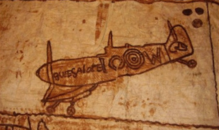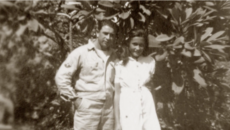TALES OF TIME - Fiji’s forgotten wartime fighter pilot
By Michael Field
In September this year, a grounds man at a lovely Yorkshire cemetery might just notice that 76 years earlier, that day, one of Fiji’s finest died.
Some how, Fiji’s first ever pilot, has slipped away from history.
The tombstone at the Commonwealth War Graves section of the Harrogate (Stonefall) Cemetery lists him, under the crest of the Royal Air Force, thus:
1553660 SERGEANT
I.D. KOMAISAVAI
(OF FIJI)
PILOT
His full name was Isikeli Doviverata Komaisavai.
When he died of pleurisy on 19 October 1944 in a hospital in Aylesbury, he was just 24-years-old.



Most people knew him as Ratu Dovi. Complicating matters further, the sole reference to him in an RAF history calls him “Raten Kokaisavai”.
His death was noted in the Fiji Times and in the Auckland Star, which the latter had under a sub-headline “Descendant of King Cakobau”.
The Star said: “Ratu Dovi was the only representative of the Fijian race to have the distinction of serving with the R.A.F.”
He was born in Tailevu, the son of Ratu Savenaca Komaisavai and Adi Miriama Komaisavai.
Like a number of the sons and daughters of high chiefs in those days, the promising children were shipped off to school in New Zealand.
Ratu Dovi (it is likely that is what he was known to his peers as) found himself at Wanganui Technical College (now Whanganui City College) from 1936 to 1939. The Star said he had “a brilliant school career” there. He was captain of the first 15 in rugby and the first 11 in cricket. He was the vice-president of the school council.
World War Two broke out in 1939. Ratu Dovi returned to Fiji, then a British colony where his uncle, Ratu Lala Sukuna, was recruiting Fijians to fight for king and commonwealth against the Nazis.

Ratu Dovi and several white settlers volunteered and were accepted for the RAF in 1941.
Through New Zealand, Ratu Dovi was taken into the British Commonwealth Training Plan and sent to Canada to learn to fly. New Zealand had 2,743 pilots trained there.
That number includes Ratu Dovi who, upon getting his wings, was sent to join No 234 (Madras Presidency) Squadron, Coastal Command.
The official RAF account of the squadron says that when Ratu Dovi joined 234, it was based in southern England. From there it was using Spitfire VBs (with the letters “AZ” on them”) to conduct sweeps over northern France, hoping to catch out German bombers. Ratu Dovi was not the only non-Britain in the squadron; it was dominated by Danes who had escaped Nazi occupation. They even purchased the planes they were to fly in.

In January 1943 it was moved to the Orkney Islands, returning south in June 1943. Its main mission at that point was convoy protection out over the ocean. For some one like Ratu Dovi, the Orkney Islands must have seemed like a frozen bleak hell.
The record is blurred now, but it looks as if Ratu Dovi become ill with the lung disease pleurisy in January 1944. Pleurisy is often a symptom of something more serious and he found himself hospitalised.
His squadron covered the Normandy invasion in June 1944 and then converted to P-51 Mustangs for long-range bomber escort duty.
Ratu Dovi made it briefly into an official RAF account of the war. He was listed as being a member of an ethnic minority community who had volunteered to serve.
“It is difficult to determine how many of the volunteers from the Colonies were ethnic minorities as the RAF had no colour bar, and did not allocate distinctive Service Numbers to ethnic personnel nor annoted a person’s Record of Service with an ethnic origin,” the account says.

“Coloured British subjects from the Colonies were eligible to join the RAF on the same terms as white subjects of the Crown.”
Ratu Dovi, for the most part, has become an unknown warrior.
His name and photo is on the roll of honour at Whanganui City College, along with others from the school who died in the war.
The Auckland Star noted: “Ratu Dovi was a descendant of Cakobau, the last Fiji king, and one of his grandparents was a signatory to the Deed of Cession.”
The street in Suva, Ratu Dovi Road, is not named after the flier but a family member of an earlier generation.
Perhaps its time to name something significant after him.
Around the world there are airports honouring celebrated aviators: Edward Logan (Boston), Edward O’Hare (Chicago), Jean Batten (Auckland International), Lofton Henderson (Honiara) and Harold Bauer (Port Vila).
So perhaps Nausori International Airport could become “Ratu Dovi International” – complete with a plaque to remember Fiji’s first and only fighter pilot.




